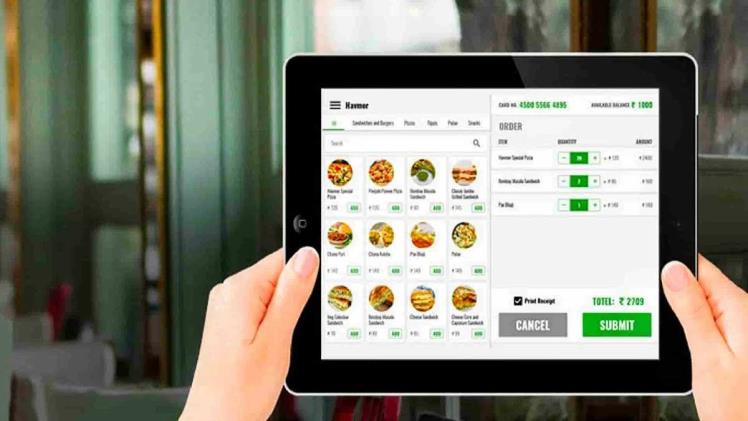An effective Online Ordering System for Restaurants must provide clear communication between front of house staff and back of house staff. Choose a solution that integrates seamlessly with your point of sale system and features a kitchen display system to display order statuses clearly.
Your KDS displays orders that your staff take and visualizes them for cooks in chronological order – ensuring accuracy, efficiency and speed in production.
Tableside Ordering
Tableside ordering allows guests to order items directly from their tables using smart devices, whether through QR codes or handheld POS systems. This kind of technology empowers your guests and ensures an enhanced dining experience that cannot be replicated through other methods.
With a QR code system, diners simply use their smartphone to scan the code with it to open up your menu onscreen, place orders, and pay. This system is flexible and straightforward to implement; making it ideal as an additional feature to offer to guests.
Handheld POS (sometimes referred to as mobile POS or mopes) systems enable your servers to bring their point-of-sale and payment systems in their hands or apron pocket. These portable hardware (like a tablet or smartphone equipped with card reader technology) is combined with software that turns it into an easily transportable checkout counter.
Tableside payments provide restaurants that want to provide their guests with an efficient, seamless dining experience, as well as increase customer engagement – which may lead to higher tips for staff. Plus, tableside payments reduce transaction processing time significantly while collecting customer data that could come in handy for loyalty programs or email marketing purposes.
Self-Service Kiosks
Self-service kiosks allow guests to have the ultimate order and payment experience by giving them control of the ordering and payment experience themselves, bypassing lines. Customers select items and pay via touchscreen interface using magistrate, EMV chip payments or mobile wallet apps such as Apple Pay or Google Pay; kiosks come either standalone units or mounted to tables – large screen and small screen versions available depending on requirements.
The kiosk software may also include upsell prompts that help restaurants increase average check sizes. For example, they could give customers the option of adding paid toppings or upgrading to premium side dishes; ultimately leading to increased profits for the restaurant.
To ensure kiosks are effective, it is crucial that staff is thoroughly tested and trained on how to use them. Employees should know how to answer customer inquiries and resolve any problems that might arise. Furthermore, it is critical that communication be provided regarding how technology will enhance work; restaurants can then shift employees around during peak periods in order to create an improved customer experience and reduce wait times – an especially helpful feature during a pandemic, when business increases significantly and they need less people in order to serve more guests.
Online Ordering
Online ordering enables customers to order food and beverages from a restaurant over the internet using their smartphone, tablet, computer or website/app and select either pick-up or delivery as a delivery option.
An ideal restaurant online ordering system should enable you to customize the look and feel of your app or website so it reflects the brand, is user-friendly, and optimized for mobile phones – especially as more orders are being placed via smartphones today than ever before.
Online ordering’s most noteworthy advantage lies in its speed. Order placement, payment processing and meal delivery all take less time compared to traditional dine-in point of sales where regular customers could wait as much as 60 minutes during peak times for their meals to arrive at home.
Mobile Ordering
Restaurants increasingly utilize mobile ordering technology to allow off-premise customers to place orders using their smartphones. Customers can access this technology either by downloading their restaurant’s own app or third-party applications that connect directly to its website and allow them to browse menus and place orders.
Restaurant online ordering systems collect customer orders and transmit them directly to POSs equipped with payments systems so customers can pay immediately for their orders. Furthermore, these systems support delivery/pickup options giving customers flexibility in how they order food from restaurants.
Customers can customize their order, set a delivery time, and receive a digital receipt – an efficient alternative to traditional phone ordering since these systems don’t involve direct interactions between staff and customers or the need for high-touch payment terminals.
Conclusion
Many restaurants turn to third-party app providers for mobile ordering services, saving the expense and headache associated with developing their own app. Third-party providers may charge either per-order fees or monthly subscription fees; when considering one as part of your strategy it’s essential that you consider how it will impact peak in-person business times and off-premise orders; an experienced third-party partner should know how best to work around any potential obstacles so as to provide seamless experiences for their customers.

